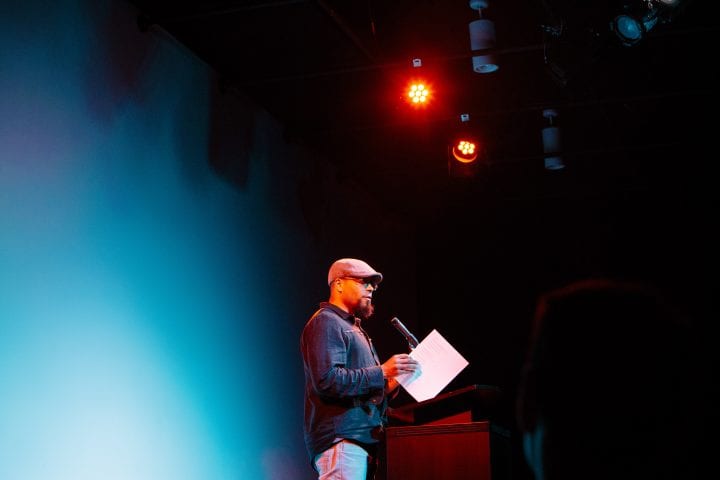
WITS Voices: The List Poem
February 18, 2020
By Daemond Arrindell, WITS Writer-in-Residence
I have been teaching a lesson focused on anaphora, aka list poems, for over ten years. I’ve used it so consistently because of the positive results it yields, especially at the beginning of a residency, when the students are still wrestling with the ideas of what poetry is “supposed to be.” The mantra I have presented to them as the grounding philosophy for our time together: If I am writing, I am doing it right.
This year, I began to look at it from a slightly different angle. One of mindfulness—a difficult achievement for any of us at any stage of development, but especially challenging, I think, for an adolescent today.
Everything moves so quickly, and they have no choice but to try and keep up: school work, family, friends, fashion, body image, social trends: Did you see this meme? Did you catch what _____________ (choose any celebrity in the youth’s sphere) said on Instagram? Teens carry around a device that can access virtually any aspect of life on this planet and dress it up to look and sound much more interesting than their own. So, how can they ever be expected to be present in the now, when there are so many things going on right now?
Back to the lesson: I ask students to pick a color and to list 20 things the color makes them think of. Objects, memories, places they’ve been, stories they’ve told to friends, foods, pets—anything that comes to mind is fair game and it doesn’t make sense. I share that “red” makes me think of turning on the heat in my car, mistakes, my ex, my mom… (Then, I take a moment to explain that my mom isn’t red, except when she gets a sunburn, but perhaps she comes to mind because she’s got such a loud and vibrant personality).
That is the warm up. Next, I ask them a series of questions to help them think more abstractly: What time of day is your color? What emotion is your color? What is a song or book or TV character that your color reminds you of? If you could touch your color, what would it feel like? All of this is anaphora, a repetitive form where the beginning of every line is the same or the end of every line is the same.
Many songs that the students still have stuck in their heads from early childhood – Old MacDonald – for example, are anaphora. We never forget them because of the repetition. I want my students to use that repetition to stay focused on one thing for the entirety of the poem they will write. One thing as their focus. Like chanting. Like meditation.
We use the chorus of the song “Bruise Brothers” by Blue Scholars, an incredibly influential Pacific Northwest HipHop duo, as a mentor text:
The blue is for the color of the collar
of my mother and my father
plus the scholars that we be,
The blue is for the nighttime moon,
swingin’ tune of every bluesman
singin’ what it’s like to not be free
The blue is for the water and sky
in the middle of the fire I burn
to find the light in the darkness
The blue is for the color of the bruise we use
to be reminded
that the body isn’t made to be timeless
I point out how deep the artist manages to go by staying focused on one topic, and through that repetition and focus, they gain a deeper understanding of what a color means to them, and a deeper understanding of themselves. I want the same for my students.
We then borrow the structure of the Blue Scholars to do our own writing. As per usual, some students go much deeper than others. And some require a helping hand to do the digging, but I appreciate that opportunity to help them see that they care capable of more than they realized. What I love the most is the surprises, when the students show me as well as themselves a level of awareness that pleasantly catches us both off guard. Those are the moments that aren’t about poetry and are all about poetry at the same time.
My Blue
by Andreia
My name is Andreia
My blue is for the sky in the night time
My blue is for the nights that hunt me in my sleep,
the nights that don’t let me see the sun
My blue is for the universe in my mind, the freedom,
the thoughts that play monopoly in my head
My blue is for the galaxy of shooting stars, devils singing,
flowers dying and kids crying
My blue is for the balloon that I let the sky steal from me,
the balloon I let go with happy memories,
My blue is for my eyes full of tears that say I miss him,
for the broken heart that knows it’s wrong to love him
My blue is for the bruise my father left on my heart
when he told me to forget, when he made me feel alone
My blue is for the door to my thoughts, feelings and happy memories,
the door that will destroy me once opened,
My blue is for the sleepless nights I pretend to be happy,
for the nights when I wanted to escape the world I live in
My blue is a mask
I put on
everyday
and say
“I’m fine, Thank You”
Blues
by Sione
My name is Sione, my blue is pain
My blue is for nights
Warm-free, as cold
As the empty black space
My blue is for fear,
Fear in my eyes,
Weak eyes,
But strong mind,
My blue is for the ghost inhale,
The smoke veils
Pain behind broken gates,
My blue is for,
Stale hearts trying to sail
Beyond heaven’s gates
My blue is for ocean waves,
Brushing currents onto sand,
Delicate, hard material of land,
Beautiful metallic sea blue waves,
From where I stand.
My blue is for pain.
What is your favorite color? What are the moments of life going on around you that it reminds you of—the ones you want to hold onto as well as the ones you’d rather forget. Take a few deep breaths, lean into those moments and write them down. Then keep going. Share with a friend.

Daemond Arrindell is a poet, performer, playwright and teaching artist. He has been a Writer-in-Residence with WITS classrooms from 5th to 12th grade for the past 11 years. He is a faculty member of TAT Lab: the Washington State Teaching Artist Training Lab, a faculty member of Freehold Theatre – leading poetry and theater residencies at Monroe Correctional Complex for men for over ten years, and an adjunct faculty at Seattle University. He also teaches with the Skagit River Poetry Foundation’s Poets in the Schools Program.